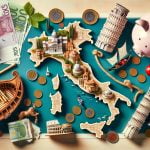Why is travel to Italy so expensive? Italy, known for its rich history, exquisite cuisine, and stunning landscapes, continues to be a highly sought-after destination for travelers around the world.
From the ancient ruins of Rome to the picturesque canals of Venice, the allure of Italy is undeniable. In this article, we will explore the factors that contribute to the high cost of traveling to Italy, as well as provide tips on how to experience this beautiful country without breaking the bank.
Italy holds a significant place in history and culture, with its contributions spanning art, architecture, and literature. The historical and cultural significance of Italy plays a major role in attracting tourists from all corners of the globe. Understanding why travel to Italy is so expensive requires delving into the demand for tourism in this magnificent country and how it impacts travel expenses.
As we dive into this topic, we will also examine how the high cost of living in Italy affects travel expenses, as well as the impact of seasonal fluctuations on travel costs. Additionally, we will explore how Italy’s iconic landmarks and tourist attractions influence pricing and delve into the role of luxury and high-end tourism in contributing to Italy’s expensive reputation.
Lastly, we will provide valuable tips for budget-friendly travel to Italy – offering insight on how to save money while still making unforgettable memories in this captivating destination.
Historical and Cultural Significance of Italy
Italy is a country rich in history and culture, making it a top destination for travelers around the world. With its breathtaking architecture, world-renowned art, and delicious cuisine, it’s no wonder that Italy continues to attract millions of tourists each year. The historical and cultural significance of Italy plays a significant role in the high cost of travel to this beautiful country.
Italy is home to numerous UNESCO World Heritage Sites, including the historic centers of Florence, Rome, and Venice, as well as iconic landmarks such as the Colosseum and the Leaning Tower of Pisa. These attractions draw in huge crowds of tourists year-round, leading to increased demand for accommodations, dining, and transportation. This high demand contributes to higher prices for tourists looking to visit these popular destinations.
In addition to its historical significance, Italy is also known for its influence on Western culture, art, and fashion. With famous cities like Milan being a hub for fashion and design, travelers are drawn not only to historical sites but also to experience the contemporary cultural scene. All these factors combine to make travel to Italy expensive due to the sheer popularity and allure of the country.
| Key Factor | Impact on Travel Costs |
|---|---|
| Unesco World Heritage Sites | Increase demand for accommodations, dining & transportation. |
| Cultural Influences | Attraction towards contemporary cultural scenes adds allure & increases costs. |
Demand for Tourism in Italy
Italy has always been a popular destination for tourists from around the world, and it’s not hard to see why. The country is steeped in history, culture, and natural beauty, offering something for every type of traveler. From the ancient ruins of Rome to the breathtaking coastline of Amalfi, Italy has a lot to offer visitors. But with such popularity comes high demand, which ultimately drives up the cost of travel to Italy.
Historical and Cultural Significance
One of the main reasons why Italy is so popular among tourists is its historical and cultural significance. As the birthplace of the Renaissance, Italy boasts some of the most iconic art and architecture in the world, drawing art enthusiasts and history buffs alike. The country’s rich culinary heritage also plays a significant role in attracting food lovers from all corners of the globe.
Influence of Italy’s Iconic Landmarks
The iconic landmarks and tourist attractions in Italy also contribute to its popularity and higher travel costs. From the Colosseum in Rome to the canals of Venice, these famous sites are must-see destinations for many travelers. As a result, prices for accommodations, tours, and other services around these landmarks tend to be higher due to their high demand.
With such high demand for tourism in Italy driven by its historical significance, cultural allure, and iconic landmarks, it’s no wonder that travel to Italy is often expensive. However, with careful planning and budget-friendly tips, it is still possible to explore this beautiful country without breaking the bank.
High Cost of Living in Italy Affecting Travel Expenses
Italy is renowned for its rich history, stunning landscapes, and delectable cuisine, making it a desirable destination for travelers from all around the world. However, one question that often comes to mind is: why is travel to Italy so expensive? A major factor contributing to the high cost of traveling in Italy is the country’s overall high cost of living.
Cost of Accommodation and Dining
The cost of accommodation in Italy can be quite substantial, especially in popular tourist hubs such as Rome, Florence, and Venice. From boutique hotels to luxury resorts, the price range for lodging options may deter budget-conscious travelers. Additionally, dining in Italy can also be expensive, particularly in touristy areas where restaurants tend to charge higher prices for meals and beverages.
Transportation Expenses
Traveling within Italy can also contribute significantly to the overall expenses. While public transportation such as trains and buses offer convenient options for getting around, the fares can add up, especially for long-distance journeys. Rental car costs and fuel prices are also factors to consider when budgeting for travel expenses in Italy.
General Cost of Goods and Services
The general cost of goods and services in Italy is relatively high compared to other European countries. From shopping for souvenirs to enjoying leisure activities such as guided tours or museum visits, these additional expenses can impact one’s travel budget.
Despite these challenges, there are ways for travelers to minimize their expenses while exploring Italy. By researching affordable accommodation options like hostels or bed-and-breakfasts, taking advantage of local transport deals or passes, and seeking out budget-friendly dining establishments or markets, travelers can still experience the beauty of Italy without breaking the bank. Furthermore, planning a visit during the off-peak season can lead to significant savings on accommodations and various attractions.
Impact of Seasonal Fluctuations on Travel Costs
Seasonal fluctuations play a significant role in the cost of traveling to Italy. The country is a popular tourist destination year-round, but the costs can vary drastically depending on the time of year. Understanding these fluctuations can help travelers better plan and budget for their Italian adventure.
During peak tourist seasons, such as the summer months from June to August and major holidays like Christmas and Easter, prices for accommodations, flights, and attractions tend to skyrocket. This is due to the high demand for travel during these times. Additionally, the warm weather and school vacations make it an ideal time for families to visit, further driving up costs.
On the other hand, traveling during the shoulder or off-peak seasons can result in significant savings. From September to November and March to May, travelers can experience lower prices for airfare and accommodations. Not only are costs lower during these times, but tourists may also find that popular attractions are less crowded, allowing for a more intimate experience.
To put it simply, understanding the seasonal fluctuations in travel costs is crucial when planning a trip to Italy. By being aware of when prices are at their highest and lowest, travelers can strategically plan their visits to make the most out of their budget while still enjoying all that Italy has to offer.
- Peak season: June-August and major holidays
- Shoulder/off-peak season: September-November and March-May
- Benefits of traveling during off-peak seasons
Influence of Italy’s Iconic Landmarks and Tourist Attractions on Pricing
Italy is known for its iconic landmarks and tourist attractions that draw millions of visitors each year. The popularity of these sites and the high demand for visiting them directly affects the pricing for travel to Italy. This is one of the main reasons why travel to Italy can be so expensive.
The historic Colosseum in Rome, the magnificent canals of Venice, and the stunning art collections in Florence are just a few examples of Italy’s iconic landmarks that attract tourists from around the world. The sheer volume of visitors to these attractions means that prices for accommodations, dining, and activities in their vicinity are often inflated. Additionally, entrance fees to popular tourist spots can be quite high, adding to the overall cost of traveling in Italy.
In addition to these iconic landmarks, Italy’s beautiful coastline and picturesque countryside also contribute to the country’s expensive reputation. Popular coastal destinations like the Amalfi Coast or Cinque Terre and scenic towns in Tuscany command higher prices due to their desirability as travel destinations.
Overall, while it’s undeniably true that Italy’s iconic landmarks and tourist attractions play a significant role in driving up travel costs, there are still ways for budget-conscious travelers to experience all that Italy has to offer without breaking the bank.
| Iconic Landmarks | Tourist Attractions |
|---|---|
| Colosseum | Rome |
| Canals | Venice |
| Art Collections | Florence |
The Role of Luxury and High-End Tourism in Italy’s Expensive Reputation
Italy has long been associated with luxury and high-end tourism, which significantly contributes to its expensive reputation as a travel destination. The country is renowned for its high fashion, exquisite cuisine, and opulent accommodations, making it a magnet for affluent travelers seeking indulgence and sophistication. Here are some factors that explain why luxury and high-end tourism play a crucial role in Italy’s expensive reputation:
1. Luxury Accommodations: Italy boasts a plethora of luxurious hotels, resorts, and villas that cater to discerning travelers with lavish amenities and impeccable service. From the grandeur of historical palazzos to the serenity of countryside estates, these upscale accommodations come with a hefty price tag that reflects their exclusivity.
2. Fine Dining and Wine Experiences: Italian cuisine is celebrated worldwide for its delectable flavors and culinary artistry. Michelin-starred restaurants, vineyard tours, and gourmet cooking classes are just some of the indulgent experiences that attract luxury travelers to Italy. The cost of fine dining and wine experiences in upscale establishments can significantly contribute to the overall expense of visiting the country.
3. Exclusive Experiences and Services: High-end tourists often seek unique and personalized experiences that showcase the best of what Italy has to offer. Private guided tours of renowned landmarks, bespoke shopping experiences in designer boutiques, and exclusive access to cultural events add a premium cost to the travel itinerary.
While luxury travel in Italy can be costly, there are opportunities for travelers to indulge in extravagance without breaking the bank. By carefully planning their trip, seeking out special promotions or packages, and prioritizing their must-have experiences, visitors can savor a taste of indulgence while staying within their budget. Ultimately, the allure of luxury in Italy adds an irresistible dimension to the country’s overall appeal as a top-tier travel destination.
Tips for Budget-Friendly Travel to Italy
In conclusion, it’s no secret that travel to Italy can be quite expensive, but understanding the reasons behind the high costs can help travelers make more informed decisions and find ways to manage their expenses. The historical and cultural significance of Italy, coupled with the demand for tourism in this beautiful country, contribute to its popularity as a travel destination.
However, the high cost of living in Italy also plays a significant role in driving up travel expenses for visitors.
Seasonal fluctuations can also impact travel costs, with peak tourist seasons leading to higher prices for accommodations, attractions, and even transportation. Additionally, the influence of Italy’s iconic landmarks and tourist attractions on pricing cannot be overlooked. The maintenance and preservation of these sites come at a cost that is often reflected in entrance fees and other related expenses for tourists.
Luxury and high-end tourism also play a significant role in Italy’s expensive reputation. From luxury accommodations to fine dining experiences, there is no shortage of high-end options for travelers looking to indulge in luxury while exploring the country. However, for those seeking budget-friendly alternatives, there are still plenty of opportunities to experience the beauty of Italy without breaking the bank.
By following some simple tips for budget-friendly travel to Italy – such as opting for off-peak travel times, choosing more affordable accommodations and dining options, and taking advantage of free or discounted attractions – travelers can enjoy all that Italy has to offer without overspending. Ultimately, by understanding the factors contributing to the expense of traveling to Italy and making savvy choices along the way, visitors can make their Italian adventure both unforgettable and financially feasible.
Frequently Asked Questions
Why Is It So Expensive to Fly to Italy?
It is expensive to fly to Italy because of several factors. One reason is the high demand for flights, especially during peak tourist seasons. Additionally, fuel prices and airline operational costs contribute to the overall expense of flying to Italy.
Is Italy Very Expensive to Visit?
Italy can be expensive to visit, but it really depends on how you plan your trip. Tourist hotspots like Rome, Venice, and Florence tend to be more expensive, while lesser-known cities and regions may offer more budget-friendly options for accommodations and dining.
What Is the Cheapest Month to Go to Italy?
The cheapest month to go to Italy is typically in the off-peak season, which falls between November and March. During this time, there are fewer tourists, lower accommodation rates, and cheaper airfares. Keep in mind that some attractions or businesses may have limited hours or even close during the low season.

I’m a passionate traveler, writer, and Italophile. My fascination with Italy’s history, art, and culture has led me on countless adventures across the Italian landscape. Through “I Live Italy,” I share my love for this extraordinary country and aims to inspire others to explore its boundless beauty.





